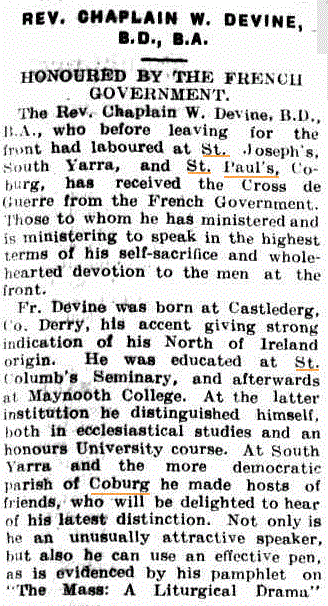Until
very recently I was unaware that Colonel Richard Edmund Courtney of Courtney’s Post fame had a connection
to Coburg.
Then I
read the reminiscences of Dr Randolph Mathew in an article in an old Coburg
Historical Society Newsletter (February 1977). The Mathew family lived in The
Grove, Coburg during the early years of the twentieth century. Dr Mathew and
his brothers Alexander, John and Mungo all served in the First World War.
Theirs was an interesting family. Their father John was the Presbyterian
minister at Coburg and a well regarded anthropologist. He was also a great patriot and on the first
big Armistice Day celebration in November 1919, he flew the Union Jack from the
tower of his home, held a brief ceremony and all present wrote their names on
the tower door.
Further into the article, Dr Mathew made reference to Charlie Dare, son of the
developer of the Moreland Park Estate, Monty Dare, and Charlie's friend – ‘a man named Courteney’.
Charlie Dare was Colonel Charles Moreland Montague Dare of the 14th Battalion.
In fact, he was the Battalion’s war diarist.
Despite
the incorrect spelling of his surname, a little detective work reveals that
the ‘man named Courteney’ was in fact Lieutenant-Colonel Richard Edmund
Courtney, who had been the first commander of the 14th Battalion. On 27 April 1915 he had brought the 14th up to a position at
Gallipoli that then took his name - Courtney's Post.
The
two men had been comrades in arms, had probably known each other before they left for the war and clearly maintained their friendship on
their early returns from the war (Courtney in 1916 due to heart strain and Dare
in 1917 to take up staff duties in Australia). Why else would they lay out a
field telephone between their two houses?
Lieutenant
William Hugh Hamilton (left), a Graduate of the Royal Military College,
Duntroon ACT, of Ballarat, Vic, who was killed on 18 May 1915 at Gallipoli.
Colonel Charles Moreland Dare sitting in a chair, smoking a pipe in centre and
Colonel Richard Edmond Courtney sitting in a deck chair outside a tent at the
Heliopolis Camp. Taken in 1915 at Heliopolis in Egypt.
Image courtesy AWM. Image A01228.
Courtney,
a solicitor in civilian life, died in October 1919 of health problems
aggravated by his war service. He is buried at Coburg Cemetery. His name has
only recently been added to the Debt of Honour Register by the Commonwealth War Graves Commission, thanks to the efforts of Essendon’s Lenore Frost.
Interestingly, his medal group and war papers have been purchased by the Maryborough Military Museum in
Queensland, so you will have the perfect excuse for a holiday in the sun if you
want to look at them in person!
Although
the Courtneys had strong connections to the Cheltenham area, the family
had lived in Coburg since around the turn of the century and
Courtney’s unmarried sister Isabella, who was his next of kin, remained in the area until her death in 1954. Several
brothers also served with distinction: one was Colonel J.H. Courtney and the
eldest brother was Brigadier-General Thomas John Courtney.













